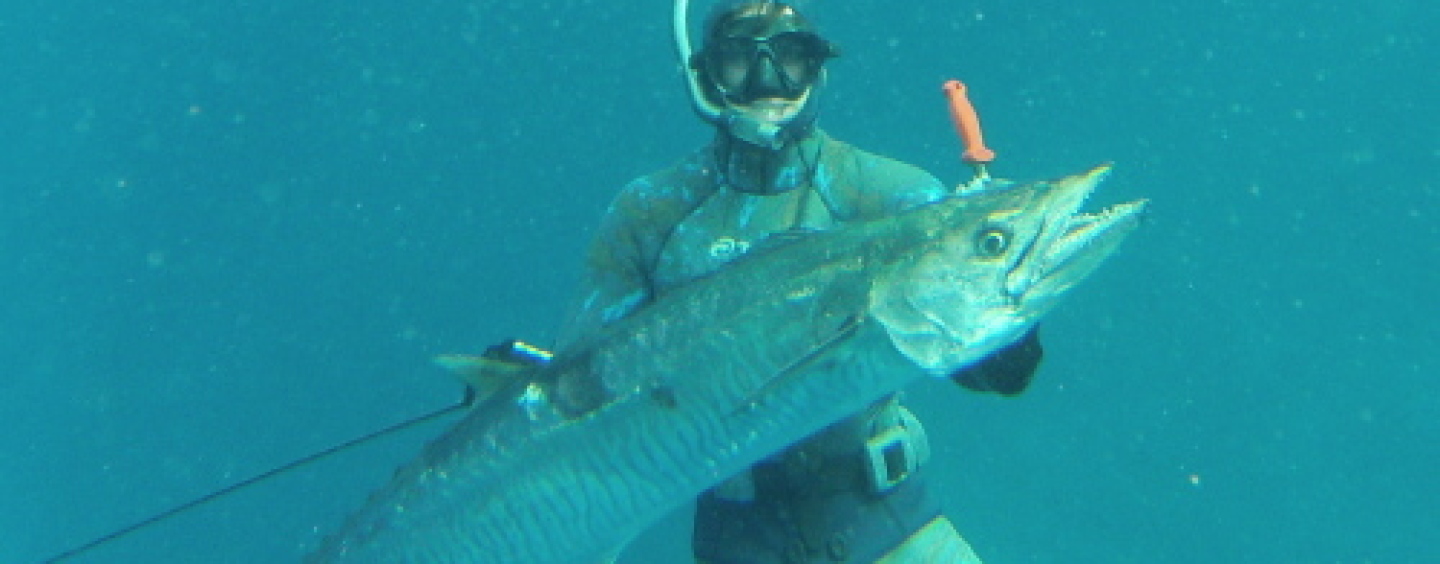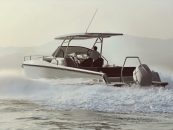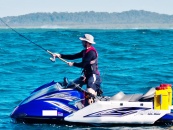A freediver prepares his descent into deeper waters. His eyes constantly looking out for the fish. He hides behind the rocks. He holds his breath. He waits. A fish swims by. He aims. He fires the speargun. He is right on target. He has caught the fish he was looking for.
Imagine the drama as it unfolds when the hunter finds the hunted—under water! This is called spearfishing.
WHAT IS SPEARFISHING?
Spearfishing is an ancient method of fishing. Some cultures still primarily use it to catch fish in rivers and streams using sharpened sticks. Although modern day spearfishing as a sport does not see spears used, the same thrill and the same tactics are necessary to ensure the catch.
“The real difference between fishing and spearfishing for me is the motivation of the outcome,” says Brendan Taylor, a local spearfisherman who had his first spearing experience when he was 15. “When I go fishing I go simply for pleasure, always on a catch and release basis. However, when spearfishing I will go to selectively choose what I will be eating. I also choose to spearfish or freedive for the thrill. There’s nothing like diving with dolphins, turtles, sharks, rays and on the odd and very special occasion, whales.”
As a sport, it differs from conventional fishing. “Spearfishing is a physically demanding sport and you catch more fish,” states Martin Wilson, another spearfishing aficionado who has been doing it for 15 years. He further describes the thrill he gets from the sport, when diving deep for that big fish. “With water pressure doubling every 10 metres, a diver gets a sense of euphoria when diving deep because of the high oxygen concentration created by the compression of the air in the diver’s lungs at depth. Cruising around at 10 metres and deeper, and looking for big fish is a real thrill!”
In Queensland, no fishing license is required to spearfish. However, only freediving is allowed. Spearfishing using scuba gear is illegal.
DANGERS AND CHALLENGES
“In the 15 years of spear fishing, I have: almost blacked out from shallow water blackout several times; been in a shark feeding frenzy at dusk pinned to rocks unable to move; been tangled in fishing line underwater and had to cut myself free while running out of air; and, caught in a rip and dragged out to sea several times,” Martin shares.
As an extreme sport, dangers are present in spearfishing. In freediving alone, there are already dangers to the body, such as a shallow water blackout. Martin explains, “As the diver approaches the surface, the expanding air in the divers lungs can actually draw oxygen out of the bloodstream into the lungs bringing a risk of passing out due to low oxygen concentration in the blood.”
Other dangers to life are close encounters with wildlife. Brendan remembers their encounter with the “men in grey suits” (sharks), two to four metres long, which started moving erratically around them as soon as they jumped in the water. “We decided to abort and head back to the shallower reefs. That got the heart going that’s for sure!”
To lower the risks of these dangers, both Brendan and Martin recommend diving with a dive buddy. “Dive with a dive buddy that you trust and has a similar diving capabilities,” advises Brendan.
GEAR AND EQUIPMENT
Spearfishing gear and equipment depend on the species is being targeted and the quality of the water where you fish.
Speargun. Brendan suggests to use a short gun (maybe one metre) in dirty waters (5 – 15m visibility) and longer one (1.2m-1.4m) in clear water (more than 20m visibility) I have a 1.4 railgun and a 1.2 roller gun. The longer a gun is, the harder it is to track through the water.
Martin recommends a European-designed spear gun with a long barrel for Southeast Queensland. You need range, which means a long gun and plenty of rubber power. Smaller guns are OK if you’re sneaking around rocks or need to swing a gun around in dirty water, but inevitably range brings a lot more fish to the dinner table, especially in offshore reefs
Flasher. A flasher is used to attract pelagic species.
Wetsuit and Gloves/Booties. Using wetsuits, gloves and booties help the diver stay warm and to protect against cuts and abrasions from underwater obstacles, such as cave walls, floors, etc. A wetsuit that is pleasantly warm will ensure the best dive times are achieved.
Fins. Long fins give more propulsion with very minimal energy exerted. A diver wants to get to the negatively buoyant depth as quickly as possible to allow gravity to pull him deeper rather than having to use fins.
Mask and Snorkel. Use the most comfortable mask you can find. This may or may not be the most expensive. It just has to feel comfortable on the face without leaking.
Weight Belt. A weight belt is required while free diving to allow a diver to move deeper in the water column more easily. It is very important that you use the correct amount of weight. To set your weight properly use should float from 0 to 10m deep. After 10 m you should start to sink. The aim is to be neutrally buoyant at the depth that you are hunting. This is to conserve energy—that is, not continuously finning towards the bottom while stalking fish.
Knives. Always take at least two knives. For killing fish, a dagger (double edged knife) is best. For going through large fish sculls, a Phillips head screw driver is a good alternative. Entanglement underwater is best resolved by quickly cutting everything that you are tangled in with a very sharp knife.
Floats and Float Lines. Floats show boats on water that there are divers in the water. They also allow the fish you might catch to be kept high in the water column, away from wobbegongs and other scavengers, as well as sharks. Once you shoot a fish, you may simply let go of the gun, return to your float, and fight the fish from the surface.
“NO SHARKS, NO FISH.”
A saying that both Brendan and Martin believe in. “Sharks are there whether I like them or not,” says Brendan. “They have stolen fish, they have harassed me, but that’s all part of the fun I suppose.”
“Sharks are after what a spearfisherman is after – a nice feed of fish. Most small and medium sized sharks will not hassle spearfishermen too much. However they can become a problem if there are struggling fish in the water,” relates Martin.
When it comes to sharks, Brendan strongly advises, “Never ever shoot one. For me I think it’s a bad karma thing. I have prodded them away before but would never pull the trigger on one.” When faced with a shark that seems threatening, Martin has this advice. “If you are concerned about the behaviour of a shark (erratic swimming behaviour, including swooping in close, etc.), you should point your spear gun at the shark. Almost all fish and sharks do not like having a spear gun pointed at them and will respond be moving out of the line of the gun. Always look at a shark, never let it see that you are not looking at it. It is best not to ascend to take a breath if a shark is in the process of swooping in to check you out. It may respond as if you are trying to escape from its presence, and trigger it to attack.”
TIPS AND TECHNIQUES
Brendan:
- For pelagic fish, use a flasher, and dive bomb unsuspecting fish, or dive and stand up tall on the bottom.
- For others, I generally just lay on the bottom for as long as I can for a fish to come in for a look.
- The more you dive/spearfish the better you become. Knowing what to look for (structure) and habits of fish while hunting is key
Martin:
- Hide around rocky areas underwater, holding your breath, and waiting for something big to swim past—good in dirty to clear water.
- Actively move along the known haunts of desirable fish (hunt) with the spear gun pointing in the direction you are swimming, with the aim of taking a fish by surprise.
- Using burley to attract fish. This is particularly effective near an underwater structure. The fish are drawn into the vicinity (and range) of the spear fisherman.
- Train to hold your breath. Get to know your gear really well. Don’t shoot at a fish unless you are sure of hitting it; otherwise you may miss, and then have lost the next opportunity. Reloading a spear gun takes time and can spook nearby fish.
MYTHS DEBUNKED
Common misconceptions, “that we shoot everything we see,” according to Brendan, are perceptions influenced by history. Martin says, “In the 1960s, there were reports of spear fisherman taking large unnecessary catches of fish, or spearing big old fish that are not useful as a food source. This has happened in the past, but has also happened with line fisherman. This is generally not the case today, for both spear fisherman and line fisherman.”
Spearfishing is very conservational because as “you can select exactly what individual fish you wish to target,” clarifies Martin. “Other forms of fishing such as line fishing are essentially active trapping, where you cannot control what individual fish you catch, and therefore have less control over the effect you have on the environment.”
Brendan also shares, “Some of the ‘linos’ (rod and reel fisherman) dislike the idea of spearfishing. I’m not really sure why. I do both. I spearfish to specifically choose what I eat. I use rod and reel for fun. I release everything I catch by rod and reel.”
It has been noted that in countries such as Australia and South Africa where the activity is regulated by state fisheries, spearfishing has been found to be the most environmentally friendly form of fishing. It is highly selective, has no by-catch, does not cause habitat damage, and does not create pollution or harm to protected endangered species.”
Martin explains how spearfishing clubs run competitions. “Spearfishing clubs reward members with point systems that are heavily weighted towards the number of species caught over the weight of the catch. This system rewards the skill of hunting a variety of fish with different behaviour and different habitats.”
The best experiences of spearfishing are the new friendships made and the stories that come from exploring new ground, the countless unscripted events that take place in and out of the water, the new species you shoot, and the many new creatures that you get to see.
SPEARFISHING ON THE GOLD COAST
No fishing license required to spearfish.
Common fish: bream, luderick, flathead, trevally and jack, reef fish, kingfish, cobia and mackerel, Jewfish, snapper, sweetlips, parrot fish, kingfish, bream, whiting
Hardest to target: Snapper
Locations:
- On the outside walls of the Gold Coast Seaway (not the inside walls, that’s illegal).
- Narrowneck artificial reef
- Burleigh headland
- Palm Beach Reef
- Kirra Reef
IMPORTANT: Consult the Queensland Department of Agriculture and Fisheries if you are unsure of locations and to obtain the latest updates on spearfishing regulations in Queensland.
Check out the Southern Queensland Spearfishing Facebook page to join a community of spearfishermen in the region.
Interview with Brendan Taylor and Martin Wilson



























